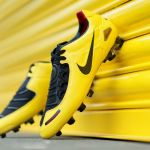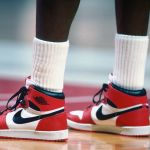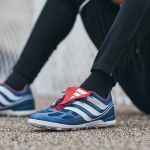.jpg)
What's wrong between sneakers and football?
Signature boots are not made for the green rectangle
March 18th, 2020
In the collective imagination, when we talk about a grail associated with basketball and football, we travel on two different tracks: for the first we think of shoes - without going too far around the Jordan -, for the second we are more inclined to think to a historic shirt, perhaps that of your favorite player in elementary school. Yet both Nike and adidas in the early 2000s had tried to get futsal shoes into our shoe cabinet, but it proved to be a weak attempt: the issue is above all of structural origin rather than cultural, aesthetic or trend-related, both that it is much easier to wear a shoe that is designed to be used on and off the field at the beginning of the production chain compared to a shoe born with studs.
For this reason, a sneaker that comes from the world of basketball is more wearable in everyday life than a soccer one that is always an "adaptation", losing that character of originality and uniqueness that would transform it into a collector's item or even just in a must have.
A turning point in this direction seemed to have come in 2002 when, on the eve of the Japanese-Korean World Cup, Nike and adidas respectively launched the ''Total 90'' and the ''Predator Mania'' which they had in the lacing - lateral for the former, covered by the iconic red tab for the latter - that characterizing element capable of making the product work even outside the playing field, without making it a simple derivation or, worse still, an unsuccessful copy of the original. Yet despite the considerable response in terms of sales, the brands have chosen to continue in the name of discontinuity, returning to focus exclusively on models for the field, without worrying about conquering that slice of public interested more in the aesthetics of the shoe than in its function.
Another substantial difference between a basketball-inspired and a football-inspired are the so-called signature shoes, shoes that through direct association with the player (by means of naming, for example), make it the only testimonial able to reflect its characteristics on the pitch. This dynamic works very well for a basketball shoe of any brand, as it is unused in the football world: for example, on February 19 Nike presented the new ''Mercurial Dream Speed 2'' through its social channels and on Instagram the question most recurrent was the release date of Cristiano's signature boots. A trivial and erroneous question since the Juventus star is a footballer who can say he tied his name to a shoe - the "Mercurial CR7" - without taking into account that the "Mercurial" was an existing model and not a model created ad hoc to replicate the peculiarities of the Madeira man. The only one who can say with certainty that he had a real signature is Leo Messi, who, with the "Messi15", inaugurated a totally new model for design and structure, devoid of the traditional appeal with the three stripes and with a customized upper designed to adapt to the shape of the Argentine's foot, to improve the touch of the ball, a principle that then inspired the subsequent futuristic-style "NEMEZIZ" line.
But Messi and Ronaldo are an exception because the rule is that of a profound difference with the world of NBA signature shoes, with many models created specifically from scratch. Whether it's historic brands - Puma with Aguero, Griezmann and Lukaku - or emerging companies - Under Armor with Depay - the choice has always been to create different PE (player exclusive) colorways based on an existing layout, without these result in real elements of novelty, such as to make one think, in a pretext, that that shoe can only be worn by that player.
Then there is the watershed example, that of adidas's "Predators": since the days of the legendary "Accelerators", the model has been redesigned several times to accompany the exploits of people such as Zidane, Beckham, Del Piero, Gerrard, Lampard and Pogba, without the German company deciding to make one of them the real face of the advertising campaign, although over time the association between the silhouette and the former English number 7 would become automatic. The reasons are further elusive if you think that in 2017 Beckham's "Predator Accelerator DB", a timeless style icon, met with incredible success despite the fact that the player had already retired for four years.
It is probably the need for particular technical recognition that is the real reason why it is difficult to talk about signature shoes, in a context in which the main exponents, after all, look a bit alike. Beckham, for example, will remain forever in the imagination however thanks to his punishments with unthinkable trajectories, skills that the rest of the midfielders could hardly replicate with such constancy, which is why the association ''Predator'' - that is the shoe with which he brought those punishments - and DB7 has strengthened more and more over time.
When we talk about off-the-pitch or off-the-court style instead, we add the fact that footballers in the post-Beckham era have "lost the train of fashion", allowing themselves to be reached and surpassed by American athletes who, above all because of streetwear - an integral part of their culture since before streetwear itself imposed its rules on the fashion world - they started to make a trend, leading the category of ''footballers'' to no longer be the primary source of inspiration for teenagers .
The process of creating and producing a shoe is long and complex: you need a basic idea of colors, shapes and materials, you need expertise in the technical assembly process, a good dose of creativity and inventiveness in the experimentation phase. Above all, you need a testimonial that is unique in its kind, that is able to ignite the imagination of the fans and that knows how to be a point of reference for the generations of the future, it is not enough to be football players capable of consolidating at high levels.








































.png)


.jpg)


.jpg)
.jpg)
.jpg)
.jpg)
.jpg)
.jpg)
.jpg)
.jpg)
.jpg)
.jpg)
.jpg)

.jpg)
.jpg)
.jpg)
.jpg)
.jpg)
.jpg)
.jpg)
























